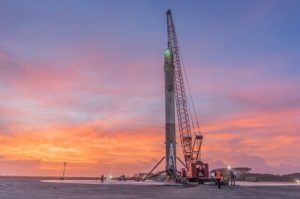The International Space Station (ISS) is about to get its first supercomputer next week. This supercomputer, called the Spaceborne Computer, has been built by Hewlett Packard Enterprise (HPE) and will be launched into space on Monday aboard SpaceX’s Dragon spacecraft.
HPE has built this supercomputer as a joint experiment with NASA.
The life of Spaceborne Computer will be about one year, roughly the time a spacecraft will take to reach Mars from Earth.
Alain Andreoil, senior vice president and general manager at HPE’s data centre infrastructure group, said in a blog post that the success of future Mars missions will depend on high-tech on-board computing resources, and sending a supercomputer to ISS is the “first step in that direction.”
According to HPE, many calculations needed for smooth functioning of space projects are carried out on Earth because of limited computing capabilities in space. This approach works perfectly for low Earth orbit mission, but if a spacecraft reaches close to Mars, a message sent by astronauts from that distance would take about 20 minutes for reach the ground station on Earth. And then it will take another 20 minutes for the response from ground station to reach astronauts.

“The data downlink from the ISS is a challenge,” said Dr Mark Fernandez, Americas CTO of SGI at HPE, while talking to Alphr.
“It’s not as fast as we would like and there are areas of LOS [loss of signal]. When the ISS is in an LOS condition, we detect that and hold the data onboard until signal is restored. This was an unexpected hurdle, but like the other aspects of hardening with software, we used software to overcome this network anomaly.”
According to Dr Fernandez, this long delay in communication could be dangerous for astronauts and the entire mission in case of an emergency situation. With supercomputer onboard a spacecraft, the results could be something no-one expected.
The HPE Spaceborne Computer is a high performance off-the-shelf computer system running on an open-source Linux operating system. Its design is based on Apollo 40 class systems, and engineers have done no hardware modifications in the system.
Generally, equipment being sent to space need to be physically “ruggedized” (or hardened) to cope up the space condition (radiation, subatomic particles, solar flares, micrometeoroids, irregular cooling, etc.). This process is very time consuming, and also costs money. Moreover, it adds extra weight for the space mission. Therefore, HPE engineers decided to adopt a different approach this time and hardened the supercomputer systems using Linux-based software.
Andreoil revealed that “HPE’s system software will allow real-time throttling of the computer systems “based on current conditions and can mitigate environmentally induced errors.”
This software will shut down the system if it detects radiation or any other issue to mitigate environmentally induced errors.
The most impressive thing about the system is that it passed NASA’s stringent safety requirements even without traditional ruggedizing. The system passed at least 146 safety tests and certifications before NASA approved it for space.
According to Dr. Fernandez, a primary goal of this experiment is to see if it is possible to send a current-generation system hardened with software and carry out quick calculations in space using this system.
Dr Fernandez says the supercomputer being sent to space is “much faster and less expensive, and results in current-generation computing power in the hands of space explorers and scientists.”
“We were provided with a maximum electrical power available, air-cooling capability and chilled water characteristics,” explains Fernandez. “No compromises were made per se. Like all HPC configurations, we of course would like more power, more cooling and more space. But we will be able to meet the objectives.”
The computer system is cooled with water that is provided by NASA, and connected to the cold water loop present inside the ISS.
“It’s going to be the most efficient computer ever, because A) it’s powered by solar cells, with zero cost of electricity, and B) it’s cooled by the coldness of space at zero dollars as well,” explains Fernandez.
“If someone tried to do the energy-efficient computations, they’d have to divide by zero somewhere.”
“It’s going to be the most efficient computer ever, because A) it’s powered by solar cells, with zero cost of electricity, and B) it’s cooled by the coldness of space at zero dollars as well”
“This project is in itself an experiment, so we’ll be eagerly awaiting the results of how it performs in the challenging conditions of space, and reviewing the entire project in real depth on its return,” concludes Fernandez.
If Spaceborne’s trial turns out to be a success, the American space agency has plans to send other sophisticated computing systems to the ISS. NASA still has many years to test such technology in space, since the first manned mission to Mars is not expected to launch before 2030s.


